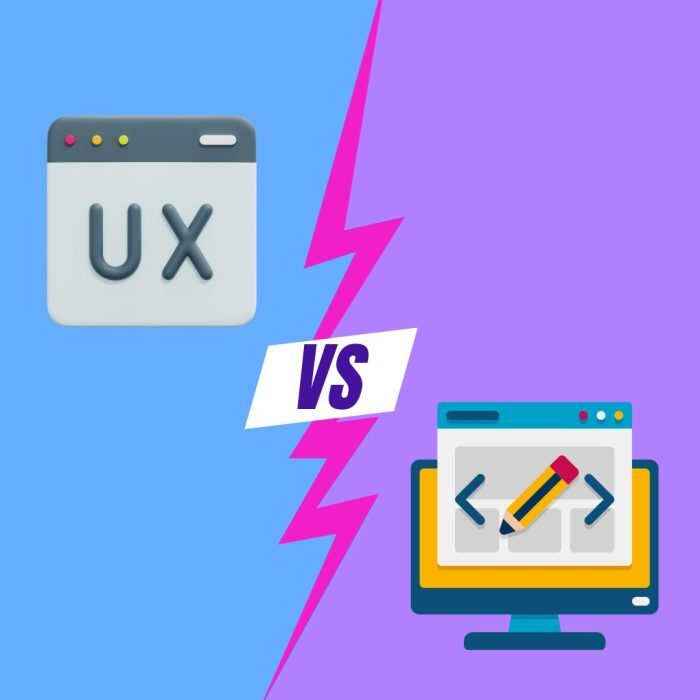Although the phrases “UX” and “Web Design” frequently coexist in the digital world, their functions are fundamentally dissimilar. For the development of a successful online platform, it is essential to comprehend the UX and Web Design Difference. While UX, or User Experience, delves further and examines how people interact with the website, Web Design largely focuses on the aesthetic appeal and the website’s visual components.
When creating a website that is both aesthetically beautiful and user-friendly, the distinction between UX and Web Design becomes crucial for guaranteeing the best possible experience for visitors. So, separating UX from Web Design is essential for a well-rounded and successful online presence.
UX and Web Design Difference

Before delving into the topic, let’s first learn the definitions and acronyms of UX, UI, and Web Design.
Definitions and Acronyms
1. UX Design: User Experience Design and Its Significance

UX Design, or User Experience design, is an approach to design that takes into consideration all aspects of a user’s interaction with a website or application. This includes everything from the user interface, graphics, and layout, to how easy it is for the user to achieve their desired tasks. The primary goal of UX design is to improve customer satisfaction and loyalty through the utility, ease of use, and pleasure provided in the interaction with a product. Thus, understanding the UX and Web Design differences becomes paramount in creating a successful digital platform.
2. UI Design: User Interface Design and Its Visual Importance

UI Design, or User Interface design, emphasizes the visual elements users interact with during their digital experience. It includes layout, colors, typography, and interactive elements like buttons and sliders. An effective UI design is visually pleasing and intuitive, significantly impacting user satisfaction and engagement.
3. Web Design: Creation and Aesthetics of Websites

Web Design encompasses the overall creation and visual aesthetics of a website. It involves aspects like graphic design, layout, color scheme, typography, and content production, which are crucial for the site’s visual appeal. Web Design is primarily focused on the look and feel of the website, ensuring it is aesthetically pleasing and aligns with the brand’s identity. Hence, understanding the difference between UX and Web Design is instrumental in crafting a site that is both visually engaging and user-friendly.
Core Differences Between UX and Web Design
1. UX Design: Focus on User Habits, Needs, Behaviors, Motivations, and Emotions
A thorough grasp of the user’s habits, needs, behaviors, motivations, and emotions is the primary driver of UX design. This field looks beyond outward appearances to examine how users interact with digital products, what drives them to use particular features, and what could frustrate or confuse them.
To learn more about the psychology of their users, UX designers do in-depth research and user testing. To create digital products that are tailored to the unique needs and preferences of users, designers examine user habits and behaviors. UX designers seek to create a smooth, intuitive, and engaging user experience that is in line with the user’s expectations and goals by taking into account their feelings and motivations. One of the fundamental distinctions between UX and Web Design is that UX Design’s primary goal is to create user-centered designs that put usability and user happiness first.
2. Web Design: Focus on Layout, Content Production, Graphic Design, and Overall Aesthetics
By focusing on layout, content creation, graphic design, and overall aesthetics, web design plays a crucial part in the development of an online platform’s visual component. It is mostly focused on a website’s aesthetic, artistic, and creative elements. Color schemes, typography, graphics, and layout are just a few of the components that web designers employ to build a visually appealing and cohesive design that reflects the personality of the company.
The objective is to design a visually attractive website that captures and holds the attention of the user. A business’s professionalism and quality can be communicated through a well-designed website, increasing client engagement and trust. However, aesthetics are only one aspect of the whole.
It’s important to keep in mind that while an aesthetically appealing site may entice visitors, without proper UX design to provide a seamless encounter, visitors may leave quickly. For this reason, developing a well-rounded, successful online presence requires an awareness of the differences between UX and web design.
Importance of UX in Business Websites and Growth

User Experience (UX) plays a pivotal role in both user satisfaction and business growth. It deepens customer engagement by creating an intuitive, seamless interaction with the website, thereby enhancing user satisfaction. A positive UX design fosters loyalty, increases user retention, and leads to repeat visits, directly influencing business growth.
More importantly, an enjoyable UX can turn visitors into advocates, promoting word-of-mouth marketing. Thus, comprehending the difference between UX and Web Design is a major step toward effective digital strategy.
Take the example of a landscaping company, “Garden Grace”. Originally their website was aesthetically pleasing but it wasn’t user-friendly and intuitive. After recognizing the UX and Web Design differences, they revamped their site focusing on UX. They simplified navigation, made forms easy to fill, added an interactive gallery of their work, and included customer testimonials.
This UX-focused redesign resulted in 35% more time spent on the site and a significant increase in service inquiries, demonstrating the power of understanding UX vs Web Design.
Understanding the differences between UX and web design is essential for business growth for owners of businesses. Although a website’s Web Design might entice visitors, a strong user experience (UX) makes sure they remain, browse, and eventually make a purchase.
High-quality photographs and a clean design may draw visitors to a website, but if the navigation is difficult to use or the content is hard to find, potential clients may leave the site, which could hurt your business.
In order to design a website that is both aesthetically pleasing and user-centered, businesses can benefit from studying UX vs. Web Design. This will maximize customer engagement and raise the possibility of conversions.
The Role of Psychology in UX Design

A crucial component of UX design is comprehending user behavior and motives. It entails probing user psychology to identify their requirements, desires, and expectations. UX designers may understand the behaviors, routines, and feelings that influence user interactions with a digital product by doing in-depth research and user testing.
This insightful knowledge makes it possible to create user-centric platforms that meet user needs and expectations, eventually increasing user satisfaction and loyalty—a key distinction between UX and web design.
It is impossible to overestimate the value of iterative design and ongoing development in UX design. These guidelines encourage a process of continuous improvement and refinement, based on user input and practical results. The user interface can continuously evolve thanks to iterative design, ensuring that it meets users’ needs and expectations.
On the other side, ongoing enhancements keep the product relevant and effective, boosting customer happiness and loyalty. UX design is distinct from merely producing visually appealing web designs because of this continual dedication to improvement.
Web Design and Its Impact on SEO

Web design significantly influences search engine performance, playing a crucial role in SEO. A well-structured and aesthetically pleasing website can increase user engagement, reducing bounce rates and thereby positively impacting search rankings. Furthermore, a website’s design elements such as its mobile-friendliness, loading speed, and easy navigation directly affect its SEO performance.
Search engines like Google prioritize sites that are user-friendly, secure, and quick to load. Therefore, while there’s a clear UX and Web Design difference, when it comes to SEO, these two disciplines must work hand-in-hand to ensure a website’s success in the digital landscape.
Content placement, keyword optimization, and user-friendly design are pivotal for effective SEO. Strategic content placement ensures that valuable information is readily accessible to visitors, enhancing user engagement and boosting search engine rankings.
Keyword optimization draws users searching for specific terms, boosting your site’s visibility. However, these efforts can be futile without a user-friendly design. An intuitive, easy-to-navigate, and visually pleasing design can significantly reduce bounce rates, increase time spent on site, and encourage repeat visits. The amalgamation of these elements results in a website that is both SEO-friendly and user-centric, exemplifying the harmonious relationship between UX and Web Design.
Salaries and Career Prospects

Depending on the amount of experience, the region, and the business, the possible income for UX, UI, and web designers varies greatly. UX designers in the US typically make roughly $90,000 per year, with more seasoned designers possibly making up to $110,000. The earning potential for UI designers is typically similar, with an average annual compensation of roughly $90,000.
The average income for web designers, who prioritize aesthetics over user experience or interaction design, is often a bit lower, hovering around $70,000 per year. Of course, these numbers can change depending on a number of variables.
The employment prospects in these disciplines remain positive, nevertheless, given the ongoing demand for these skills in the constantly changing digital economy. Professionals can improve their market positioning and income potential by comprehending the distinction between UX and web design.
Call to Action

Think about how well your present website is performing. Is it visually appealing, easy to use, and successful in grabbing and holding your audience’s attention? To achieve the best user experience that converts into business growth, take into account finding a balance between UX and Web Design Differences. Don’t be afraid to make the essential improvements to fuel your success online.
Conclusion
A strong online presence in the current digital era requires a seamless fusion of both UX and Web Design. It is possible to create websites that are not only aesthetically pleasing but also intuitive and user-friendly by understanding the UX and Web Design Difference. User retention, increased engagement, and eventually business success depend on this mix.
Owners of businesses are urged to make investments in both UX and web design in order to promote growth. An ideal online presence is ensured by striking a balance between eye-catching graphics and user-centered design. Increased consumer engagement and conversions, not only improve the user experience but also fuel business growth.







